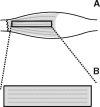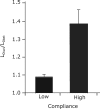Can Strain Dependent Inhibition of Cross-Bridge Binding Explain Shifts in Optimum Muscle Length?
- PMID: 29873724
- PMCID: PMC6104710
- DOI: 10.1093/icb/icy050
Can Strain Dependent Inhibition of Cross-Bridge Binding Explain Shifts in Optimum Muscle Length?
Abstract
Skeletal muscle force is generated by cross-bridge interactions between the overlapping contractile proteins, actin and myosin. The geometry of this overlap gives us the force-length relationship in which maximum isometric force is generated at an intermediate, optimum, length. However, the force-length relationship is not constant; optimum length increases with decreasing muscle activation. This effect is not predicted from actin-myosin overlap. Here we present evidence that this activation-dependent shift in optimum length may be due to a series compliance within muscles. As muscles generate force during fixed-end contractions, fibers shorten against series compliance until forces equilibrate and they become isometric. Shortening against series-compliance is proportional to activation, and creates conditions under which shortening-induced force depression may suppress full force development. Greater shortening will result in greater force depression. Hence, optimum length may decrease as activation rises due to greater fiber shortening. We discuss explanations of such history dependence, giving a review of previously proposed processes and suggesting a novel mechanistic explanation for the most likely candidate process based on tropomyosin kinetics. We suggest this mechanism could change the relationship between actin-myosin overlap and cross-bridge binding potential, not only depressing force at any given length, but also altering the relationship between force and length. This would have major consequences for our understanding of in vivo muscle performance.
Figures








References
-
- Abbott BC, Aubert XM.. 1952a. Changes of energy in a muscle during very slow stretches. J Physiol 117:104–17. - PubMed
Publication types
MeSH terms
Grants and funding
LinkOut - more resources
Full Text Sources
Other Literature Sources
Research Materials

